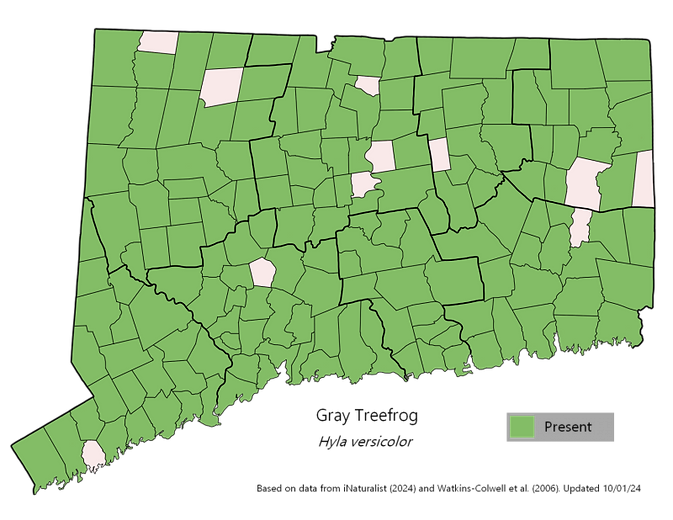Gray Treefrog
Hyla versicolor
Conservation Status:
State Status: Secure (NatureServe, 2024)
Global Assessment: Least Concern (IUCN, 2020)
Listen to call:
(HerpNet, 2009)
Description
Gray treefrogs grow to be about two inches long (Watkins-Colwell, 2024). They range in color from gray to green and are able to change between these shades based on their environment. They have lumpy skin with darker mottling and bright yellow visible on the inner thighs. Younger frogs appear a brighter green color and have fewer markings. Males have darker throats during the breeding season.
Habitat
These arboreal frogs are most commonly found in deciduous forests. They may also be found on rock ledges and around urban or suburban areas.
Behavior
This species is solitary and primarily arboreal. They can often be seen resting on tree branches or out in the sun during the day. It is very common to hear males calling out during the summer.
Gray treefrogs eat small invertebrates including insects, arachnids, and slugs. They rely heavily on their camouflage to protect them from predators. If they need to escape from a threat, the yellow on their thighs would flash and alert the attacker (Quinn, 2020).
This species breeds in the early summer in vernal pools or other forms of temporary water. Males will call out to females from the water and eggs are laid in clumps.
Range

These two species of arboreal frogs are often confused. Gray treefrogs are lighter in color, ranging from gray to green and have a darker mottling pattern across their skin. Peepers are brown and have a distinct 'X' marking on their backs, and are typically smaller in size than treefrogs. They also have a pointier snout and thinner build than treefrogs. The differences in color and pattern can clearly be seen in the images above.
References
HerpNet. (2009, March 20). Eastern gray treefrog calling. YouTube. https://www.youtube.com/watch?v=2kd5c4p8-0M.
iNaturalist. (2024). Observations. California Academy of the Sciences / National Geographic Society. https://www.inaturalist.org/observations?place_id=49&taxon_id=23783.
International Union for Conservation Of Nature and Natural Resources. (2020, December 21). Gray Treefrog. https://www.iucnredlist.org/species/55687/193371642.
NatureServe. (2024, November 1). Dryophytes versicolor. https://explorer.natureserve.org/Taxon/ELEMENT_GLOBAL.2.102087/Dryophytes_versicolor.
Quinn, D. P. (2020). Gray Treefrog. Connecticut Herpetology. https://www.ctherpetology.com/gray-treefrog.
Watkins-Colwell, G. J. (2024). Gray Treefrog - Hyla versicolor. Yale Peabody Museum. https://peabody.yale.edu/explore/collections/herpetology/guide-amphibians-reptiles-connecticut.
Watkins-Colwell, G. J. et al. (2006). New Distribution Records for Amphibians and Reptiles in Connecticut, with Notes on the Status of an Introduced Species. Sacred Heart University. https://digitalcommons.sacredheart.edu/cgi/viewcontent.cgi?article=1058&context=bio_fac.
Page updated November 19, 2024


